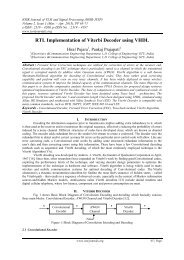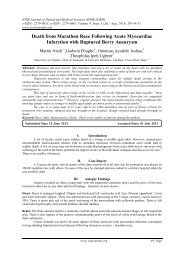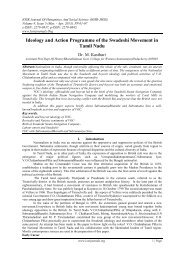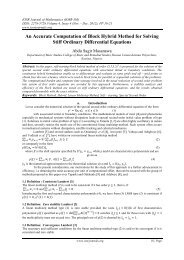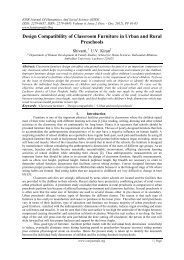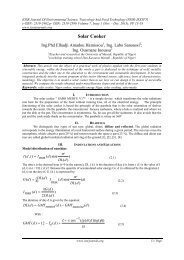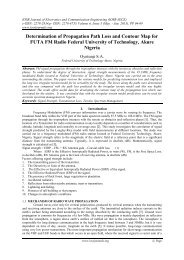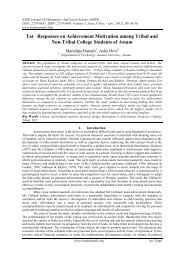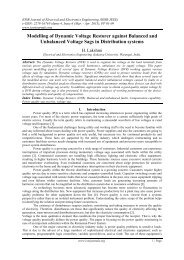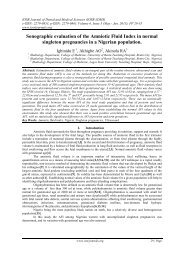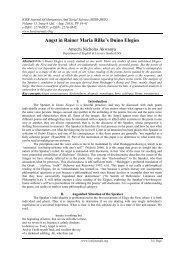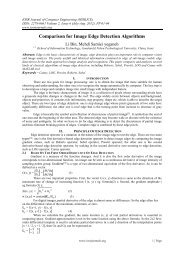Initial Conquest of India by Turks and Their Slaves - IOSR
Initial Conquest of India by Turks and Their Slaves - IOSR
Initial Conquest of India by Turks and Their Slaves - IOSR
You also want an ePaper? Increase the reach of your titles
YUMPU automatically turns print PDFs into web optimized ePapers that Google loves.
<strong>Initial</strong> <strong>Conquest</strong> Of <strong>India</strong> By <strong>Turks</strong> And <strong>Their</strong> <strong>Slaves</strong><br />
80-84. It was probably within this area that the passes <strong>of</strong> the “Sang-i-Surkh” (Red Mountain) were situated<br />
through which both Yalduz <strong>and</strong> Aibak retreated from Ghazni. Minhaj, p. 194-35; Sec also Raverty; Notes on<br />
Afghanistan, pp. 38-9; Trans. Tabakat-i-Nasiri, p. 538, note.<br />
Minhaj, p. 116. It mentions Bhima as the reigning king <strong>of</strong> Anhilwara, but inscriptions <strong>and</strong> other Hindu records<br />
ascribe this victory to Mularaja II; <strong>India</strong>n Antiquary, 1877, p. 186 <strong>and</strong> 198. See also<br />
Forbes,A.K.,Rasmala:Hindoo Annals <strong>of</strong> the Province <strong>of</strong> Goozerat in Western <strong>India</strong>,2 vols (London, 1924). (ed.<br />
Rawlinson) I, p. 199; Ojha,Gourishankar.H; Rajputaneka Itihasa,Ajmer,1927, i, p. 220. Cf. Ray,H.C.; Dynastic<br />
History <strong>of</strong> Northern <strong>India</strong>.3 Vols.Calcutta University 1931-35, ii, p. 1004-5, A fragmentary inscription at Kiradu<br />
near Mt. Abu, dated V.S. 1235 (1178 A.D. records the repair <strong>of</strong> a temple broken <strong>by</strong> a Turushka army, possibly<br />
referring to Muizz-ud-din‟s invasion, Epigraphia lndica, xi, p. 72).<br />
N. Lees etal.; (eds) Tabaqat-i-Nasiri <strong>of</strong> Abu Umar al-Juzjani (Calcutta, 1894), p. 116-18; Ferishta,Qasim b.<br />
Hindu Khan;Tarikh-i-Ferishta (Lucknow, 1864), p. 52-57; A.M. Husian (ed); Futuhus-Salatin <strong>of</strong> Isami (Agra,<br />
1938), vs. 1315-22[Hereafter Isami]; I.H. Siddiqui; Perso-Arabic Sources <strong>of</strong> Information on the Life <strong>and</strong><br />
conditions in the sultanate <strong>of</strong> Delhi (New Delhi, 1992) p. 57.<br />
N. Janardan Kirtane; „The Hammira Mahakavya <strong>of</strong> Nagach<strong>and</strong>ra Suri’, <strong>India</strong>n Antiquary (1890), p. 202, 215-<br />
17.<br />
Ojha; Rajputana, i. p. 266.<br />
<strong>India</strong>n Antiquary, 1890, p. 202; Sarda,H.N; Ajmer,Historical <strong>and</strong> Descriptive.Ajmer,1911.p. 79.<br />
<strong>India</strong>n Antiquary, 1890, p. 215-17.<br />
1 <strong>India</strong>n Antiquary, xii, p. 17. Thomas,Edward;Chronicles <strong>of</strong> the Pathan Kings <strong>of</strong> Delhi,London1871, p.<br />
59,[Hereafter,Thomas Chronicles] noticed a coin <strong>of</strong> one Kilhana with the Arabic legend reading „Sina‟ on the<br />
observe, which, according the him, is found only on the coins <strong>of</strong> Masud III. Kilhana in that case must originally<br />
have been Masud‟s feudatory who had latter rebelled <strong>and</strong> fortified the route from Pakpattan.<br />
Ishwariparasad;History <strong>of</strong> Medieval <strong>India</strong>,Allahabad,1925, p. 177, states that Sirhind, in Patiala, 100<br />
miles n.w. <strong>of</strong> Karnal was the first place captured. He relies on the printed text <strong>of</strong> Minhaj, p. 118, which has<br />
Sirhindah <strong>and</strong> in this is supported <strong>by</strong> later histories <strong>of</strong> like the Anonymous;Mirat-i-Jahan Numa,B.M.Or.1998 f.<br />
50a, <strong>and</strong> Nurul Haqq Dehlavi; Zubdatul-Twarikh,I.O.1805 f.7b.(Cf Habibullah Foundation),Ferishta <strong>and</strong> Bakshi,<br />
Nizamuddin; Tabaqat-i-Akbari,(a)ed.De <strong>and</strong> Husain,3 Vols,Calcutta,1927-41.(b)Trans.B.De.3 Vols Cal.1913-<br />
40, however have Bhatindah; Ferishta, i. p. 5 <strong>and</strong> 7; Tabaqati-i-Akbari ,i. p. 37 Raverty, op. cit, p 457, note 3,<br />
however informs us that in all the Miss. Collated <strong>by</strong> him it is written Tabarhinda, which is also found in<br />
Sirhindi,Yahya;Tarikh-i-Mubarakshahi,(a)ed.M.Hidayat Husain , Bib.Ind. Calcutta , 1931. (b)Eng. Trans.<strong>by</strong><br />
K.K.Basu,Baroda,1932 p. 7, Badauni, i. p. 49 <strong>and</strong> Haji Dabir, ii, p. 677.Habibullah opines that no such place is<br />
known to have ever existed no one acquainted with the hurried style <strong>of</strong> writing Persian Characters can fail to see<br />
that transposition <strong>of</strong> a few dots <strong>and</strong> a careless joining <strong>of</strong> letters are all that is required to make Bhatindah read<br />
Tabarhindah <strong>and</strong> even Sirhind.Sirhind seems to be very improbable,for the shortest route from Lahore to<br />
Hindustan lay through western Patiala in which Bhatindah is situated. No remains <strong>of</strong> any strong fort, such as<br />
that which withstood Prithviraja‟s assault for over a year, were found in Sirhind. On the other h<strong>and</strong> in<br />
Bhatindah, Garrick noticed a strong massive fort <strong>and</strong> also heard local legends respecting Muizz-ud-din‟s attack<br />
on the place; Cunningham Reports, xxiii, p. 2-3. According to Raverty, op. cit; p. 458, note, the Lubbut-twarikhi-Hind,<br />
states that “Tabarhindah is now known as Bhatindah”. But Ishwariprasad asserts that Shirhind was<br />
known as Bhatindah.Cf Habibullah,Foundation.<br />
1 (Minhaj, p.119).<br />
1 Minhaj, p. 118. Ferishta, pp. 5-7 <strong>and</strong> Tabaqati-i-Akbari, i. p.37, state that is was fought at Narain, near Tarain,<br />
"in the district <strong>of</strong> Sirsuti.").<br />
1 For details <strong>of</strong> the Tactics followed see Tarikh-i-Mubarak Shahi, p.9).<br />
1 Minhaj p.120.<br />
1 Hasan Nizami;Tajul-Maasir(a)I.O.1486,(b)I.O.209,(c)B.M.Add.7623,(d)Add.7624, f. 44b. Minhaj states that<br />
he was immediately executed. For the absurd story <strong>of</strong> Ch<strong>and</strong> Bardai <strong>of</strong> how prithviraja, blinded <strong>and</strong> kept in<br />
conferment at Ghazni, was yet able with the help <strong>of</strong> Ch<strong>and</strong> himself, to slay Muizz-ud-din before his own<br />
execution, see Ch<strong>and</strong> Bardai;Prithviraja Raso,ed.M.V.P<strong>and</strong>ia <strong>and</strong> Sam Sundar Das,Nagari Pracharini Sabha ,<br />
Benaras,1913 vi: also Raj Darshani, f. 49a.<br />
Minhaj, p.120; Fakhruddin Mubarakshah,(Known as Fakhre Mudabbir);Tarikh-i-Fakhruddin<br />
Mubarakshah,ed.E.D.Ross,London,1867, p. 22).<br />
Ibn al-Athir,Izzal-Din,al-Kamil fi‟l-Ta‟rikh,ed.C.J.Tornberg; Ibn-El-Athiri Chronicon quod perfectissimum<br />
inscribitur (Leiden,1851-76,12 vols.); repr.(with different pagination) Dar al-Sader (Beirut,1386/1966,12<br />
vols.)(references are to both editions,in that order), XI, 115/174, wa-iltazamu lahu bil-awwal.Cf.Jackson<br />
Peter;The Delhi Sultanate,A Political <strong>and</strong> Military History,Cambridge,1999; Tajul Maathir. Fol. 50b. for the<br />
chieftains <strong>of</strong> the Delhi region specifically(Cf Habibullah Foundation)<br />
www.iosrjournals.org<br />
10 | Page



